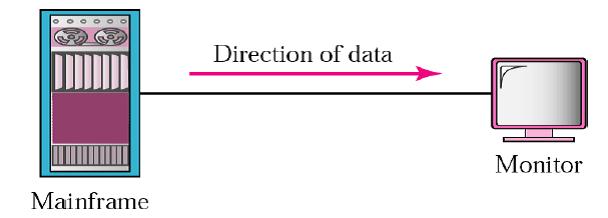Different Data Flow Directions
Communication between any two devices can be simplex, half-duplex, or full-duplex.
1. Simplex:
In simplex mode, the communication is unidirectional, as on a one-way street. Only one of the two devices on a link can transmit; the other can only receive which can be represented in the following figure.

Keyboards and traditional monitors are examples of simplex devices. The keyboard can only introduce input; the monitor can only accept output. The simplex mode can use the entire capacity of the channel to send data in one direction.
You May Also Like:
Data Communications and Its Characteristics
Characteristics of Networks
Protocols and Standards
Components of Data Communication
2.Half-Duplex:
In half-duplex mode, each station can both transmit and receive, but not at the same time. When one device is sending, the other can only receive, and vice versa which will represent in the following figure.

The half-duplex mode is like a one-lane road with traffic allowed in both directions. When cars are traveling in one direction, cars going the other way must wait. In a half-duplex transmission, the entire capacity of a channel is taken over by whichever of the two devices is transmitting at the time. Walkie-talkies and CB (citizens band) radios are both half-duplex systems.
The half-duplex mode is used in cases where there is no need for communication in both directions at the same time; the entire capacity of the channel can be utilized for each direction.
3.Full-Duplex:
In full-duplex mode (also called duplex), both stations can transmit and receive simultaneously as shown in the following figure.

The full-duplex mode is like a two-way street with traffic flowing in both directions at the same time. In full-duplex mode, signals going in one direction share the capacity of the link: with signals going in the other direction. This sharing can occur in two ways: Either the link must contain two physically separate transmission paths, one for sending and the other for receiving; or the capacity of the channel is divided between the signals traveling in both directions.
One common example of full-duplex communication is the telephone network. When two people are communicating by a telephone line, both can talk and listen at the same time. The full-duplex mode is used when communication in both directions is required all the time. The capacity of the channel, however, must be divided between the two directions.
You May Also Like:
Different Types of Connections
Types of Topologies
Types of Networks
Back to DCN Questions and Answers

